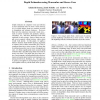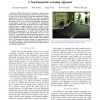16 search results - page 1 / 4 » Evolving visual sonar: Depth from monocular images |
PRL
2006
13 years 4 months ago
2006
To recover depth from images, the human visual system uses many monocular depth cues, which vision research has only begun to explore. Because a given image can have many possible...
VIS
2004
IEEE
14 years 6 months ago
2004
IEEE
Most data used in the study of seafloor hydrothermal plumes consists of sonar (acoustic) scans and sensor readings. Visual data captures only a portion of the sonar data range due...
IJCAI
2007
13 years 6 months ago
2007
Depth estimation in computer vision and robotics is most commonly done via stereo vision (stereopsis), in which images from two cameras are used to triangulate and estimate distan...
ICVGIP
2008
13 years 6 months ago
2008
Following the phenomenological approach of gestaltists, sparse monocular depth cues such as T- and X-junctions and the local convexity are crucial to identify the shape and depth ...
ICRA
2008
IEEE
13 years 11 months ago
2008
IEEE
Abstract— Mobile robots rely on the ability to sense the geometry of their local environment in order to avoid obstacles or to explore the surroundings. For this task, dedicated ...


